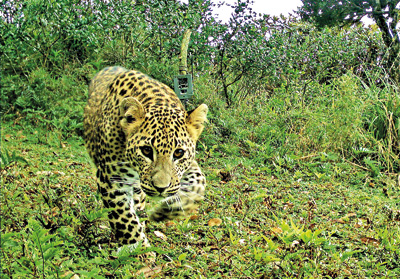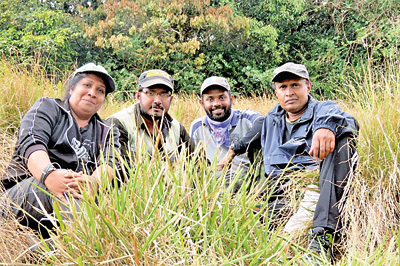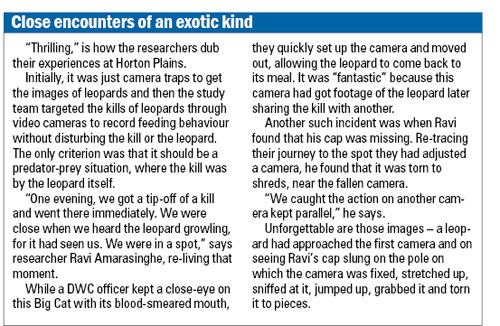News
On the trail of the elusive ‘hunters’ of the sambar plains
They came, they peered at it with large beautiful eyes and fortunately for them curiosity did not kill the cats – the nosy parkers were an adult and two cubs.

A naughty cub that the research team has been following. Photos courtesy of the researchers
What they were inquisitive about was a camera trap, nothing to do with them but set up as a training exercise which later evolved into a major study of Sri Lanka’s leopard (Panthera pardus kotiya) not in the Dry Zone where this country’s largest predator strides majestically but in the cold climes of Horton Plains.
The videos of the three acted as ‘bait’ to whip up curiosity which led to the lure of going after more information through a targeted study from 2015 to 2018.
Trudging off the beaten track, with permission from the Department of Wildlife Conservation (DWC), hungry, footsore and chilled to the bone sometimes, the team has “captured” some amazing footage not only of the leopard but also of other animals.
The research team comprised Dr. Enoka P. Kudavidanage of the Tropical Ecosystem Research Network (TERN) and Sabaragamuwa University; primary researcher Ravindra (Ravi) Amarasinghe and Thilina Nimalrathna; and DWC personnel Sumith Indika Bandara, Charitha Lakmali Wanninayaka and Piyal Ravindrakumar (who was the previous Warden of the Horton Plains National Park).
The international collaborator and resource provider (for the expensive cameras and other technical equipment) was the National University of Singapore (NUS) with support being extended by Prof. Edward L. Webb, Yan Ru Choo and Marcus Chua.
Dr. Kudavidanage and Prof. Webb were the Principal Investigators in the study.
“We set up camera traps in Horton Plains purely for teaching purposes,” laughs Enoka, giving the backdrop of how it all began.
She and Ravi had been engaged in conservation work in Horton Plains since 2014 and on completing her PhD from NUS had initiated ecology training programmes for a 16-member group comprising NUS and Sabaragamuwa students and DWC staff.
Defining camera traps as a basic ecological technique used to check out the presence or absence of a species or an individual, Enoka says that the traditional methods to monitor the presence and behaviour of animals are transect lines and observations.
“However,” she laments that when carrying out these traditional methods, animals are sensitive to human presence. But camera traps enable the ‘capture’ of animals as images as they pass back and forth unaware that they are being photographed.

Time for a photo – the researchers (from left) Dr. Enoka P. Kudavidanage, Thilina Nimalrathna, Sumith Indika Bandara and Ravindra (Ravi) Amarasinghe at Horton Plains
It was when they were teaching their students how to set up camera traps that they caught on video the three faces with big eyes, coming and nosing the camera. “It was amazing,” recalls Enoka – it was an adult leopard and two cubs.
Securing the relevant permits from the DWC, they then set about studying the leopards of Horton Plains in mid-2015, initially with 38 cameras at 19 locations.
Earlier, they sent out drones to map Horton Plains and get a close-up view of its vegetation. With the findings that Horton Plains covering an area of 32 square kilometres consists of montane grasslands and subtropical montane evergreen forests, they picked on grasslands first and set about ‘sampling’ every square km with two cameras each.
This is the systematic way of carrying out a population estimation, says Ravi.
All this was done in close coordination with the DWC, Enoka is emphatic, while also picking the brains of the Wildlife Conservation Society (WCS) in Malaysia.
“We got their expertise in identifying the indirect signs that leopards had passed through, in addition to the pictures captured by camera traps,” she says, explaining that they included hair, claw marks on trees, scat (droppings), odour of urine and pug marks.
Hands-on the training was, with the study team being sent into the cages of the leopards at the Dehiwela Zoo to become familiar with the scents, of course, without the leopards in them.
Enoka and Ravi reiterate that special training is required to set up camera traps, with the height at which they should be installed, at what angle and on what kind of structure – tree or pole – they should be on, having to be decided on meticulously. After the cameras capture the data, there should also be systematic documentation.
Later, they extended the study to the forests too setting up 68 cameras at 32 locations, covering the whole of Horton Plains to get the full sample.
Every month, during the study period the team entered the grasslands and forests on foot, visited the camera-locations to collect data and changed the batteries. A strong plea goes out from Enoka to all her colleagues engaged in research and those who are on the threshold of such studies to remember that “we are entering a habitat which is pretty much undisturbed and we have no right to disturb the animals living there. It is their home and we are the intruders”.
Enoka and Ravi have had a yearning to create a link between their research and the DWC’s conservation work to enable the DWC staff performing important work to benefit from their technology.
They plan to continue the leopard work at Horton Plains, while encouraging the use of camera traps to monitor other endangered species in other areas. This would help us to see what is happening in Sri Lanka’s Protected Areas, says Enoka, explaining that it would give them a ‘pulse’ rate on whether the wild animal populations are increasing or decreasing and whether climate change is affecting them.
“We will use all of this evidence-based information for the conservation of the Sri Lankan leopard in general and those in the montane regions in particular,” she adds.
| The exciting findings – leopards love the glades & feast on sambar | |
| The cub photographs captured on the camera traps are ample proof that Horton Plains is a breeding habitat, says Dr. Enoka Kudavidanage, overjoyed over this positive aspect. The researchers have not named the leopards yet, only numbered them. Of reams of photographs — more than 50,000 — about 10,000-15,000 ‘captures’ were of leopards. We have currently identified 23 individual leopards in this four-year study in Horton Plains, says Enoka, pointing out that the Spatially Explicit Capture Recapture (SECR) method is a scientific technique used to estimate the population correctly, based on recording and re-recording the presence of an animal in the given habitat. The numbers could vary as some migrate during the mating season and as such the density could be lesser than that determined by SERC. Some of the leopards may be crossing Horton Plains and not be residing there. Leopards laze around mostly in forest glades, resting alone or sometimes as couples during the mating season and thereafter with cubs. A “cute” male haunted a particular spot at least once a week for three months, smiles Enoka. Based on scat (droppings) analysis, the team has identified about 110 samples of common kills of leopards – mainly sambar, barking deer, hare, birds and monkeys. An incident over which there was much joy was when they monitored a leopardess with a lump on its side and saw that the growth had disappeared after about six months, most probably healing naturally. The ‘side-prizes’ caught on camera were the Rusty-spotted cat, the Black-naped Hare, wild boar, porcupine, Bear Monkey (the montane version of the Purple- faced Leaf Monkey), brown mongoose, barking deer, Stripe-necked Mongoose and birds in their variety including peacocks (usually seen in the Dry Zone), spurfowl (shy and hard to spot) and raptors. |


